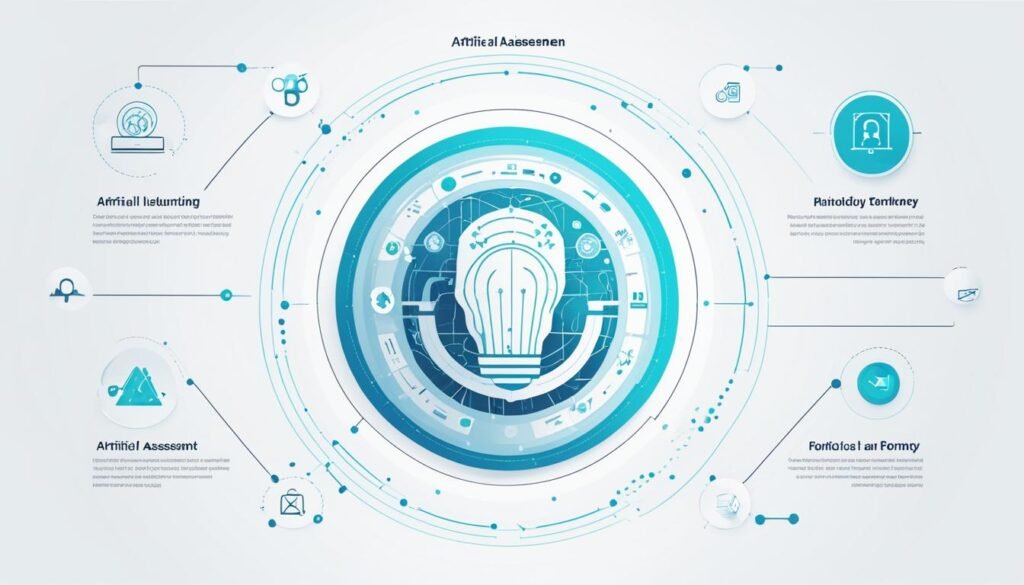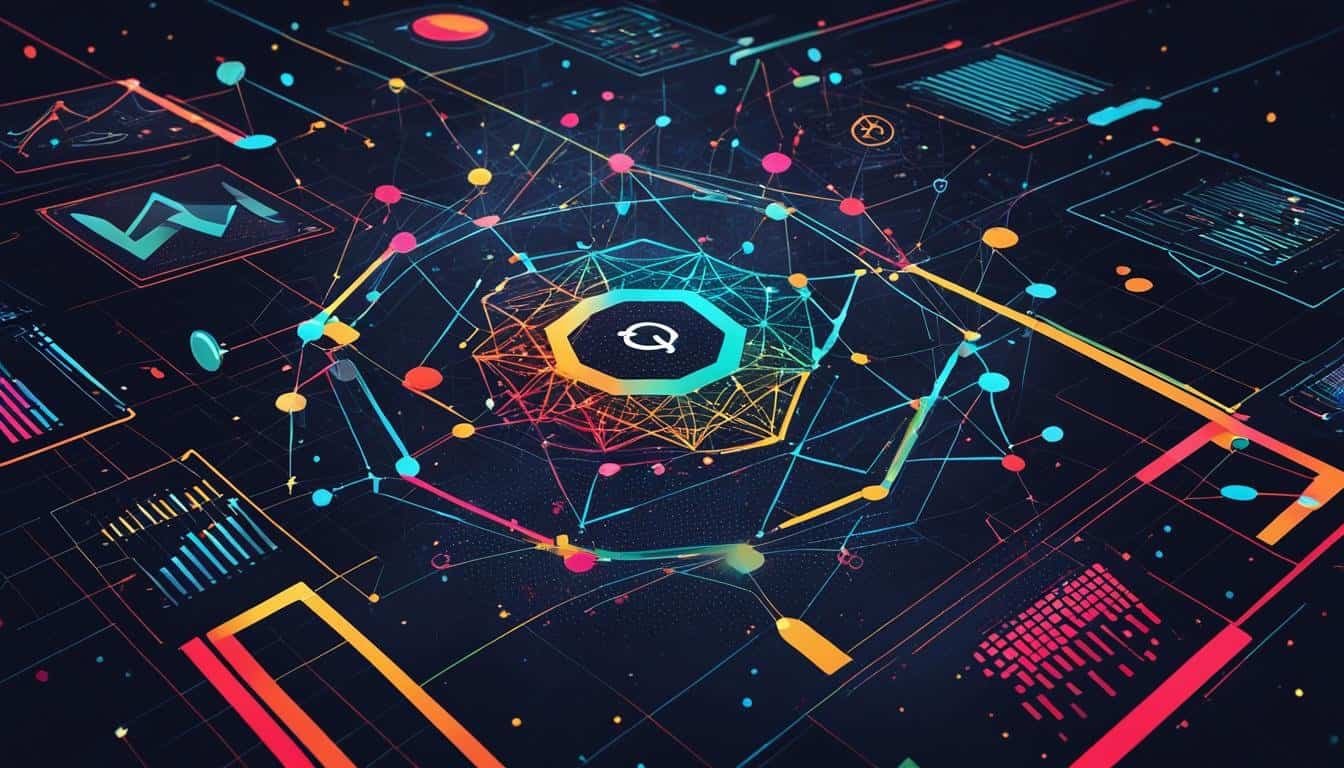AI for Risk Compliance and Regulatory Monitoring in Business
Artificial intelligence (AI) is revolutionizing risk compliance and regulatory monitoring in the business world. It has become a crucial tool for governance, risk management, and compliance (GRC) efforts, particularly in fraud detection and protection. AI solutions are being integrated into GRC software platforms, offering significant improvements in areas such as regulatory change management, policy management, control management, and third-party risk management. The potential use cases for AI in risk compliance and regulatory monitoring are vast, including enhanced detection and monitoring capabilities, predictive planning, and prioritization of risk assessments. By incorporating AI into GRC architectures, businesses can streamline compliance processes, reduce noncompliance risk, and stay updated with evolving regulations.
Key Takeaways:
- AI is revolutionizing risk compliance and regulatory monitoring in business, offering significant improvements and advancements.
- Integration of AI in GRC software platforms streamlines compliance processes and enhances detection and monitoring capabilities.
- AI enables predictive planning and prioritization of risk assessments, helping businesses proactively manage compliance risks.
- By incorporating AI, businesses can reduce noncompliance risk, improve efficiency, and stay updated with evolving regulations.
- The potential use cases for AI in risk compliance and regulatory monitoring are extensive, making it a crucial technology for GRC efforts.
The Complex Landscape of Compliance
Compliance is a multifaceted endeavor that encompasses various laws, regulations, industry standards, and internal policies. Businesses must navigate this complex landscape to avoid legal repercussions, financial penalties, and damage to their reputation.
Traditional compliance monitoring methods are often manual, time-consuming, and prone to human error, making them inadequate for today’s fast-paced business environment. AI technologies offer innovative solutions to streamline compliance processes, reduce risks, and enhance overall efficiency.
With the help of AI, businesses can automate data analysis, monitor compliance in real-time, and leverage predictive analytics to proactively identify potential compliance issues.
The Challenges of Compliance
“The complexity of compliance continues to grow, requiring businesses to adopt advanced technologies to ensure adherence to regulations and minimize risks.”
The Benefits of AI in Compliance Monitoring
- Streamlined compliance processes
- Risk reduction
- Enhanced efficiency
- Real-time monitoring and detection
- Predictive analytics
By incorporating AI into compliance monitoring, businesses can stay ahead of regulations and proactively address potential compliance issues. AI-powered systems can automate data analysis, identify patterns, anomalies, and potential violations, and provide real-time insights for better decision-making.
The Role of AI in Compliance Monitoring
Artificial Intelligence (AI) is playing a pivotal role in transforming compliance monitoring within the Governance, Risk Management, and Compliance (GRC) framework. The integration of AI-powered tools has revolutionized how organizations identify and address potential compliance violations efficiently.
One of the key benefits of AI in compliance monitoring is its ability to automate data analysis. AI algorithms can process vast amounts of structured and unstructured data, enabling organizations to quickly identify patterns, anomalies, and potential compliance breaches. This automated data analysis improves accuracy and saves valuable time for compliance teams.
Real-time monitoring is another critical aspect of AI in compliance. By leveraging AI technology, organizations can monitor transactions, communications, and activities in real-time, allowing them to detect compliance breaches as they happen. The ability to monitor activities in real-time provides businesses with the opportunity to proactively address compliance issues and mitigate potential risks.
AI’s predictive analytics capabilities further enhance compliance monitoring by identifying potential compliance issues based on historical data. With machine learning algorithms, AI systems can analyze historical data to identify patterns, anomalies, and trends that could signify potential compliance issues. This enables organizations to predict and prevent compliance breaches before they occur.
Natural Language Processing (NLP) technology is instrumental in making AI systems understand and interpret human language. This capability enables AI systems to analyze regulatory texts and internal policies, making it easier for compliance teams to ensure adherence to complex regulations. NLP helps organizations automate the analysis of large volumes of regulatory information, ensuring accurate and efficient compliance monitoring.
AI also reduces the number of false positive alerts in compliance monitoring. By leveraging AI algorithms, organizations can refine their monitoring systems to accurately identify true compliance violations, reducing the time and effort required to investigate false positives. This improves the overall efficiency of compliance monitoring processes.
Furthermore, AI offers customization and scalability in compliance monitoring. Organizations can tailor AI systems to their specific compliance needs, allowing for a more personalized and effective monitoring approach. The scalability of AI systems allows businesses to adapt as compliance requirements evolve and expand.
Another valuable feature of AI in compliance monitoring is its ability to generate comprehensive audit trails and documentation. AI systems automatically document compliance monitoring activities, providing organizations with an audit trail of their compliance efforts. This documentation is crucial for demonstrating regulatory adherence and facilitating internal and external audits.
Overall, AI plays a crucial role in compliance monitoring by automating data analysis, enabling real-time monitoring, leveraging predictive analytics, facilitating NLP-based analysis, reducing false positives, offering customization and scalability, and generating comprehensive audit trails and documentation. By incorporating AI into compliance monitoring processes, organizations can enhance their compliance efforts, reduce risks, and ensure regulatory adherence.
AI Compliance Monitoring: Importance and Benefits
AI compliance monitoring plays a crucial role in enabling organizations to meet regulatory requirements, reduce risks, and mitigate potential compliance issues. By harnessing the power of AI algorithms, businesses can revolutionize the way they ensure adherence to regulations, bringing accuracy, efficiency, and scalability to the compliance monitoring process.
One of the key advantages of AI compliance monitoring is its ability to quickly analyze large volumes of data, enhancing the accuracy and speed of compliance monitoring. By automating data analysis, AI algorithms can identify patterns, anomalies, and potential compliance violations more efficiently than manual methods. This not only saves time but also improves the overall accuracy of compliance monitoring.
Furthermore, AI’s continuous learning and adaptability enable organizations to stay up-to-date with evolving compliance regulations. As regulations change and new requirements emerge, AI systems can quickly adapt and adjust their monitoring capabilities to ensure ongoing compliance.
Implementing AI compliance monitoring brings a range of benefits to organizations. Firstly, it saves time by automating tedious and time-consuming manual compliance processes. By freeing up valuable resources, businesses can focus on other critical aspects of their operations.
Secondly, AI-driven compliance monitoring improves efficiency by streamlining the identification and assessment of potential compliance issues. AI algorithms can analyze data in real-time, enabling prompt detection of compliance breaches and timely actions to mitigate risks.
Thirdly, AI compliance monitoring helps organizations reduce costs associated with noncompliance. By identifying potential compliance issues early on, businesses can take proactive measures to mitigate risks and avoid costly legal consequences.
Lastly, AI compliance monitoring enables better-informed decision-making by providing comprehensive insights based on accurate and up-to-date data analysis. This empowers organizations to make informed and strategic compliance decisions that align with regulatory requirements and business objectives.
In summary, AI compliance monitoring is of utmost importance for organizations, offering a multitude of benefits. By leveraging AI technology, businesses can ensure regulatory adherence, reduce risks, save time, cut costs, and make informed compliance decisions. As the business landscape continues to evolve, AI compliance monitoring will play a crucial role in enabling organizations to navigate complex compliance requirements effectively.
Key Components of AI Compliance Monitoring

AI compliance monitoring relies on several key components to ensure efficient and effective monitoring. These components work together seamlessly to enable businesses to proactively identify and address potential compliance issues. The key components of AI compliance monitoring include:
- Data Collection and Processing: AI systems gather both structured and unstructured data from various sources, such as documents, emails, and transactions. This data is then processed using advanced machine learning algorithms to identify patterns, anomalies, and potential compliance violations.
- Risk Assessment: AI algorithms analyze the collected data to assess the level of risk associated with potential compliance issues. By evaluating historical data and identifying trends, these algorithms can provide insights into areas that require closer monitoring and potential risk mitigation strategies.
- Real-time Monitoring and Alerting: AI systems continuously monitor data streams and transactions in real-time. They compare the current behavior against expected patterns and promptly detect any deviations that may indicate non-compliance. If a potential violation is detected, the AI system generates alerts or notifications for further investigation and action.
By leveraging these components, AI compliance monitoring empowers businesses with the ability to proactively identify and address compliance issues in a timely manner, reducing potential risks and enhancing overall compliance efforts.
Real-time Monitoring and Alerting in Action
“We implemented an AI compliance monitoring system that continuously analyzes our data streams and transactions. Within weeks, we noticed a significant increase in our ability to detect potential compliance violations in real-time. The system generated instant alerts, allowing us to take immediate action and prevent further non-compliant behavior. This proactive approach has helped us save both time and resources, while ensuring compliance with regulatory requirements.” – Sarah Thompson, Compliance Officer at ABC Corporation
The real-time monitoring and alerting component of AI compliance monitoring provides businesses with the agility and responsiveness needed to address compliance issues swiftly. By detecting deviations from expected behavior in real-time, organizations can take immediate action to mitigate risks and protect their reputation.
Challenges and Considerations of AI Compliance Monitoring
While AI compliance monitoring offers immense benefits, organizations must also address various challenges and considerations to ensure its effectiveness and ethical implementation.
Data Privacy
When utilizing AI for compliance monitoring, protecting data privacy is of utmost importance. Organizations must establish robust data protection protocols to safeguard sensitive information and ensure compliance with relevant privacy regulations, such as the General Data Protection Regulation (GDPR) or Personal Information Protection and Electronic Documents Act (PIPEDA).
Algorithmic Bias
Algorithmic bias is a crucial concern that organizations must address in AI compliance monitoring. Biased algorithms can lead to unfair outcomes and discriminatory practices. To mitigate bias, organizations need to invest in diverse and representative data sets, conduct regular audits of the AI models, and implement measures for ongoing bias detection and correction.
Human Oversight
While AI plays a pivotal role in compliance monitoring, human oversight remains essential. Complex compliance matters may require human judgment, interpretation, and decision-making. Organizations must strike a balance between automation and human involvement to ensure accurate and ethical compliance monitoring.
Ethical Considerations
AI compliance monitoring raises ethical considerations that organizations must address proactively. Ethical frameworks must be established to guide the development, deployment, and use of AI technologies. Organizations should consider the potential impact of AI decisions on individuals, communities, and society as a whole, and ensure transparency and accountability in their compliance monitoring processes.
“Regulations and laws surrounding AI are still developing, and organizations must stay updated and compliant as more complex laws and regulations emerge.”
| Challenges and Considerations | Solutions and Best Practices |
|---|---|
| Data Privacy | Establish robust data protection protocols and comply with relevant privacy regulations. |
| Algorithmic Bias | Invest in diverse and representative data sets, conduct regular audits, and implement measures for bias detection and correction. |
| Human Oversight | Strike a balance between automation and human involvement to ensure accurate and ethical compliance monitoring. |
| Ethical Considerations | Establish ethical frameworks, consider the impact of AI decisions, and ensure transparency and accountability. |
Best Practices for Implementing AI in Compliance Monitoring
Implementing AI in compliance monitoring requires careful planning and execution. By following these best practices, organizations can effectively leverage AI in compliance monitoring, improving accuracy, efficiency, and regulatory adherence.
- Define clear objectives: Clearly define the objectives for implementing AI in compliance monitoring. This will help ensure that the AI model is aligned with the organization’s compliance goals and requirements.
- Ensure data accuracy and quality: Accurate and high-quality data is crucial for training AI models effectively. Organizations should invest in data cleansing and validation processes to ensure the accuracy and reliability of the data used in compliance monitoring.
- Foster collaboration between compliance and technology teams: Collaboration between compliance and technology teams is essential for successful AI implementation. Compliance teams can provide the necessary domain expertise, while technology teams can contribute their technical knowledge to develop and deploy AI models for compliance monitoring.
- Regularly monitor and update the AI model: AI models need to be monitored and updated regularly to ensure their effectiveness over time. As compliance regulations evolve, organizations must update the AI model to stay compliant and effectively mitigate risks.
By implementing AI with clear objectives, ensuring data accuracy and quality, fostering collaboration between compliance and technology teams, and regularly monitoring and updating the AI model, organizations can enhance their compliance monitoring efforts and stay ahead in the ever-changing regulatory landscape.
AI Implementation Best Practices in Compliance Monitoring:
“AI implementation in compliance monitoring requires a strategic and collaborative approach. Clear objectives, accurate data, collaboration between compliance and technology teams, and regular monitoring are key factors for success.”
– Jane Smith, Compliance Officer, ABC Corporation
Future Trends and Innovations in AI Compliance Monitoring
The future of AI compliance monitoring holds exciting advancements and innovations. Advanced machine-learning algorithms will enhance the detection and analysis of compliance breaches and potential risks. Natural Language Processing (NLP) will enable AI systems to analyze unstructured data, such as emails and contracts, more effectively. The integration of chatbots and virtual assistants will improve communication and provide real-time guidance on compliance-related matters. As technology continues to advance, organizations can expect further innovations in AI compliance monitoring, empowering them to stay ahead of compliance requirements and effectively mitigate risks associated with non-compliant behavior.
In the coming years, advanced machine-learning algorithms will revolutionize AI compliance monitoring, enabling organizations to identify compliance breaches and potential risks with greater accuracy and efficiency. These algorithms will be capable of analyzing vast amounts of data, providing actionable insights and real-time notifications to compliance teams. By leveraging AI’s analytical capabilities, businesses can proactively address compliance issues, saving time and resources while minimizing the risk of non-compliance.
Natural Language Processing (NLP) will play a key role in enhancing AI compliance monitoring. AI systems will be able to understand and interpret complex regulatory texts, contracts, and other unstructured data, extracting relevant information and identifying potential compliance issues. This will significantly improve the speed and accuracy of compliance monitoring, enabling organizations to stay up-to-date with changing regulations and mitigate risks more effectively.
The integration of chatbots and virtual assistants into AI compliance monitoring tools will streamline communication between compliance teams and employees. Chatbots can provide real-time guidance on compliance-related matters, answer common questions, and assist in policy adherence. Virtual assistants can enhance training programs by providing interactive and personalized learning experiences, ensuring employees have a deep understanding of compliance requirements.
As organizations strive to stay ahead of compliance requirements, future innovations in AI compliance monitoring will continue to transform the way businesses meet regulatory obligations. From advanced machine-learning algorithms and NLP to chatbots and virtual assistants, these advancements will enable businesses to navigate the complex landscape of compliance with greater efficiency and confidence.
Key Innovations in AI Compliance Monitoring
| Innovation | Description |
|---|---|
| Advanced machine-learning algorithms | Enhances detection and analysis of compliance breaches and risks |
| Natural Language Processing (NLP) | Enables effective analysis of unstructured data, such as contracts and emails |
| Chatbots and virtual assistants | Improves communication and provides real-time guidance on compliance-related matters |
Conclusion
AI is revolutionizing risk compliance and regulatory monitoring in business, bringing significant advancements to the field. By incorporating AI technologies, businesses can streamline compliance processes, reduce noncompliance risk, and enhance overall efficiency.
One of the key benefits of AI in compliance monitoring is its ability to automate data analysis. AI-powered systems can process large volumes of structured and unstructured data in real-time, enabling businesses to monitor compliance more effectively. This automation not only improves accuracy but also saves time and reduces costs associated with manual monitoring.
Looking ahead, future trends in AI compliance monitoring will focus on the development of advanced machine-learning algorithms and natural language processing capabilities. These advancements will enhance the detection and analysis of compliance breaches, empowering businesses to proactively identify and address potential risks.
In addition, the integration of chatbots and virtual assistants will revolutionize communication and provide real-time guidance on compliance-related matters. This will further enhance the efficiency of compliance monitoring processes and ensure businesses stay ahead of evolving regulations.
In conclusion, AI is revolutionizing risk compliance and regulatory monitoring, offering numerous benefits to businesses. By embracing AI technologies and staying updated with future trends, organizations can effectively mitigate risks associated with non-compliant behavior and ensure adherence to regulatory requirements.







